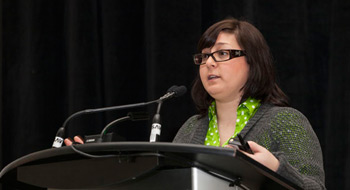

Although the Benefits Canada Employers Cancer Care Summit, held last week in Toronto, was about disease, the focus was on people.
Karen, a 58-year-old teacher, first saw her doctor when she started coughing blood to later be diagnosed with Stage 3A adinocarcinoma lung cancer. In addition to accessing public healthcare, Karen consulted CAREpath’s cancer navigation services, the Canadian Cancer Society and a homeopath.
“Her care was driven by the public system, but having the private in the background made her journey better,” said Dr. Anglin, medical director of CAREpath, a cancer assistance and support program available to employers.
Read more
- Patient assistance program primer
- Download speaker presentation
- 2013 Employers Cancer Care Summit Photos
Anglin explained that contrary to what employers might assume, he has noticed that employees don’t get particularly upset when asked to pay out of pocket for part of their care costs. People do realize that the government can’t always pay for everything, so employers shouldn’t worry that employees won’t use services just because they might have to invest some of their own money.
Karen’s story provided a real-world example, but Cheryl-Anne Simoneau and Anne Marie Cerato’s presence at the conference put energetic faces to the morning’s message that cancer is not a death sentence and that employers can offer valuable support.
Diagnosed with chronic myelogenous leukemia (CML), Simoneau is now the president of the CML Society, which provides support, education and information on the disease.
Some of the ways she suggested employers could help their employees with cancer are as follows:
- institute buddy programs to provide extra support;
- link employees with patient-support groups;
- provide transition programs to help employees become reintegrated into the workforce; and
- offer flex-time options repayable on recovery.
But perhaps Simoneau’s best and most reinforced advice was “don’t leave them out of the loop” but rather include patients at every step in the process.
“What can all institutions do? Encourage cancer patient engagement through all levels of the decision-making process,” she said. “Often changes are made without consulting patients, but patients often have solutions for you.”
Cerato, a bubbly 30-something who you would not pick out as the room’s lung cancer patient, detailed her journey with the disease from diagnosis through treatment and return to work.
She talked in particular about the challenges that young cancer patients can face, including loneliness, a potential loss of independence and stress.
As a teacher with the Toronto District School Board, Cerato was lucky to have good benefits but still found it daunting to figure out how to access services and communicate with her employer, particularly when reeling from a diagnosis.
Cerato, who blogs at thesearemyscars.org, strongly recommends that workplaces mandate an HR person to deal with leaves in order to help employees navigate the system. She also echoed Simoneau’s advice on including employees in decision-making and advised that employers be aware of potential side effects such as fatigue and stress when making return-to-work plans.
